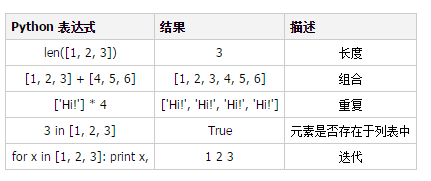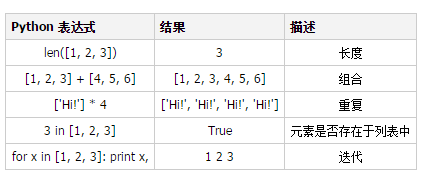 Backend Development
Backend Development
 Python Tutorial
Python Tutorial
 Detailed explanation of Python list (List) operation methods
Detailed explanation of Python list (List) operation methods
Detailed explanation of Python list (List) operation methods
List is the most basic data structure in Python. List is the most commonly used Python data type. The data items of the list do not need to be of the same type. Each element in the list is assigned a number - its position, or index, with the first index being 0, the second index being 1, and so on.
Python has 6 built-in types for sequences, but the most common are lists and tuples. Operations that can be performed on sequences include indexing, slicing, adding, multiplying, and checking members. In addition, Python has built-in methods for determining the length of a sequence and determining the largest and smallest elements.
1. Create a list
Just enclose the different data items separated by commas in square brackets. As shown below:
list1 = ['physics', 'chemistry', 1997, 2000]; list2 = [1, 2, 3, 4, 5 ]; list3 = ["a", "b", "c", "d"];
2. Access the values in the list
Use the subscript index to access the values in the list. You can also use square brackets to intercept characters, as shown below:
#!/usr/bin/python list1 = ['physics', 'chemistry', 1997, 2000]; list2 = [1, 2, 3, 4, 5, 6, 7 ]; print "list1[0]: ", list1[0] print "list2[1:5]: ", list2[1:5]
The output result of the above example:
list1[0]: physics list2[1:5]: [2, 3, 4, 5]
3. Update the list
You can modify or update the data items of the list, or you can use the append() method to add list items, as shown below:
#!/usr/bin/python list = ['physics', 'chemistry', 1997, 2000]; print "Value available at index 2 : " print list[2]; list[2] = 2001; print "New value available at index 2 : " print list[2];
The output result of the above example:
Value available at index 2 : 1997 New value available at index 2 : 2001
4. Delete the elements of the list
You can use the del statement to delete the elements of the list, as shown in the following example:
#!/usr/bin/python list1 = ['physics', 'chemistry', 1997, 2000]; print list1; del list1[2]; print "After deleting value at index 2 : " print list1;
The output result of the above example :
['physics', 'chemistry', 1997, 2000] After deleting value at index 2 : ['physics', 'chemistry', 2000]
5. Python list script operators
The list operators + and * are similar to string operators. The + sign is used for combined lists, and the * sign is used for repeated lists.
is as follows:

6. Python list interception
Python list interception and string operations Type, as follows:
L = ['spam', 'Spam', 'SPAM!']
Operation:

7. Functions and methods of Python list operations
List operations include the following functions:
1. cmp(list1, list2): Compare the elements of two lists
2. len(list): The number of list elements
3. max(list): Return the maximum value of the list elements
4. min(list): Returns the minimum value of list elements
5. list(seq): Convert tuples to lists
List operations include the following methods:
1. list.append(obj): At the end of the list Add a new object
2, list.count(obj): Count the number of times an element appears in the list
3, list.extend(seq): Append multiple elements from another sequence at the end of the list at one time value (extend the original list with a new list)
4. list.index(obj): Find the index position of the first matching item of a value from the list
5. list.insert(index, obj): Insert the object into the list
6, list.pop(obj=list[-1]): Remove an element in the list (default is the last element), and return the value of the element
7, list.remove(obj): Remove the first matching item of a value in the list
8, list.reverse(): Reverse the elements in the list
9, list.sort([func]): Sort the original list
For more detailed explanations of Python list (List) operation methods and related articles, please pay attention to the PHP Chinese website!

Hot AI Tools

Undresser.AI Undress
AI-powered app for creating realistic nude photos

AI Clothes Remover
Online AI tool for removing clothes from photos.

Undress AI Tool
Undress images for free

Clothoff.io
AI clothes remover

Video Face Swap
Swap faces in any video effortlessly with our completely free AI face swap tool!

Hot Article

Hot Tools

Notepad++7.3.1
Easy-to-use and free code editor

SublimeText3 Chinese version
Chinese version, very easy to use

Zend Studio 13.0.1
Powerful PHP integrated development environment

Dreamweaver CS6
Visual web development tools

SublimeText3 Mac version
God-level code editing software (SublimeText3)

Hot Topics
 How to solve the permissions problem encountered when viewing Python version in Linux terminal?
Apr 01, 2025 pm 05:09 PM
How to solve the permissions problem encountered when viewing Python version in Linux terminal?
Apr 01, 2025 pm 05:09 PM
Solution to permission issues when viewing Python version in Linux terminal When you try to view Python version in Linux terminal, enter python...
 How to avoid being detected by the browser when using Fiddler Everywhere for man-in-the-middle reading?
Apr 02, 2025 am 07:15 AM
How to avoid being detected by the browser when using Fiddler Everywhere for man-in-the-middle reading?
Apr 02, 2025 am 07:15 AM
How to avoid being detected when using FiddlerEverywhere for man-in-the-middle readings When you use FiddlerEverywhere...
 How to teach computer novice programming basics in project and problem-driven methods within 10 hours?
Apr 02, 2025 am 07:18 AM
How to teach computer novice programming basics in project and problem-driven methods within 10 hours?
Apr 02, 2025 am 07:18 AM
How to teach computer novice programming basics within 10 hours? If you only have 10 hours to teach computer novice some programming knowledge, what would you choose to teach...
 How to efficiently copy the entire column of one DataFrame into another DataFrame with different structures in Python?
Apr 01, 2025 pm 11:15 PM
How to efficiently copy the entire column of one DataFrame into another DataFrame with different structures in Python?
Apr 01, 2025 pm 11:15 PM
When using Python's pandas library, how to copy whole columns between two DataFrames with different structures is a common problem. Suppose we have two Dats...
 How does Uvicorn continuously listen for HTTP requests without serving_forever()?
Apr 01, 2025 pm 10:51 PM
How does Uvicorn continuously listen for HTTP requests without serving_forever()?
Apr 01, 2025 pm 10:51 PM
How does Uvicorn continuously listen for HTTP requests? Uvicorn is a lightweight web server based on ASGI. One of its core functions is to listen for HTTP requests and proceed...
 How to handle comma-separated list query parameters in FastAPI?
Apr 02, 2025 am 06:51 AM
How to handle comma-separated list query parameters in FastAPI?
Apr 02, 2025 am 06:51 AM
Fastapi ...
 How to solve permission issues when using python --version command in Linux terminal?
Apr 02, 2025 am 06:36 AM
How to solve permission issues when using python --version command in Linux terminal?
Apr 02, 2025 am 06:36 AM
Using python in Linux terminal...
 How to get news data bypassing Investing.com's anti-crawler mechanism?
Apr 02, 2025 am 07:03 AM
How to get news data bypassing Investing.com's anti-crawler mechanism?
Apr 02, 2025 am 07:03 AM
Understanding the anti-crawling strategy of Investing.com Many people often try to crawl news data from Investing.com (https://cn.investing.com/news/latest-news)...





